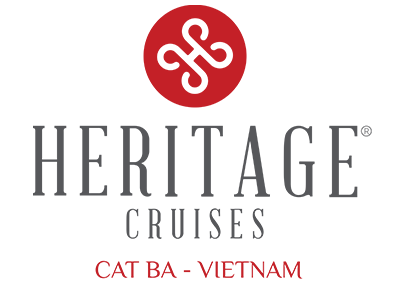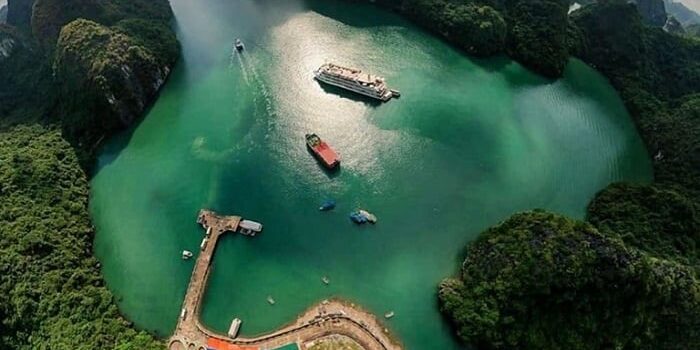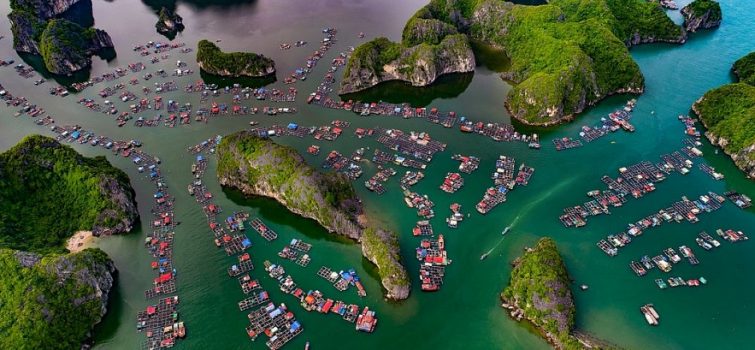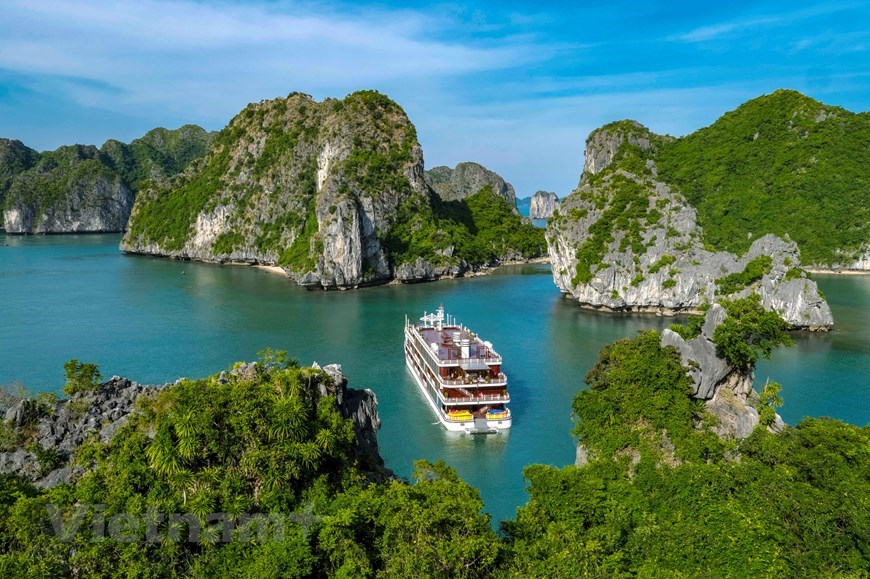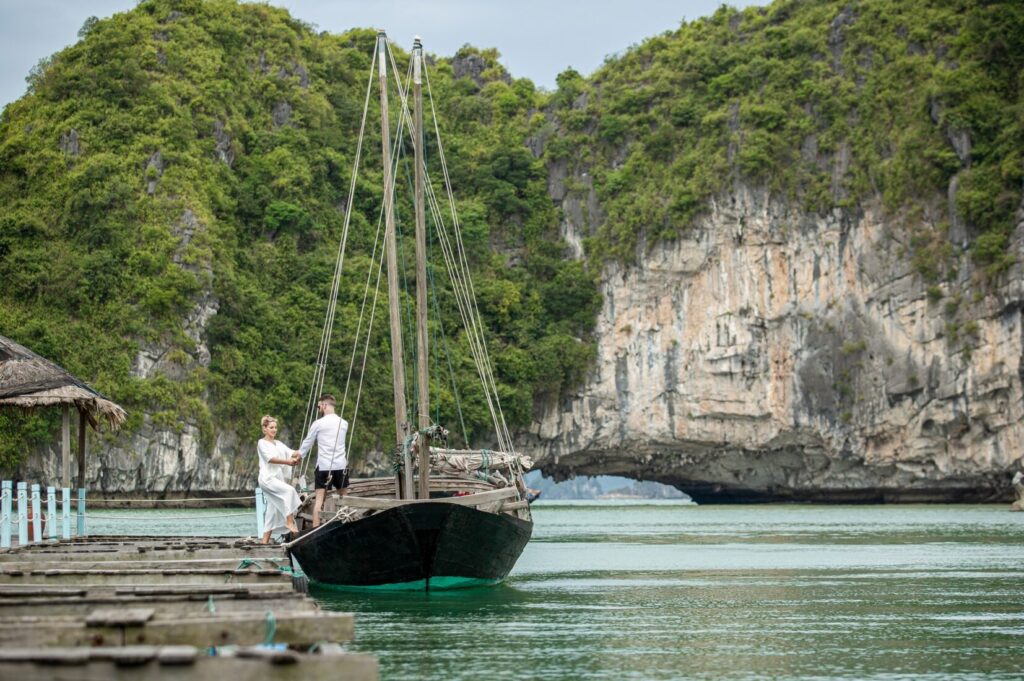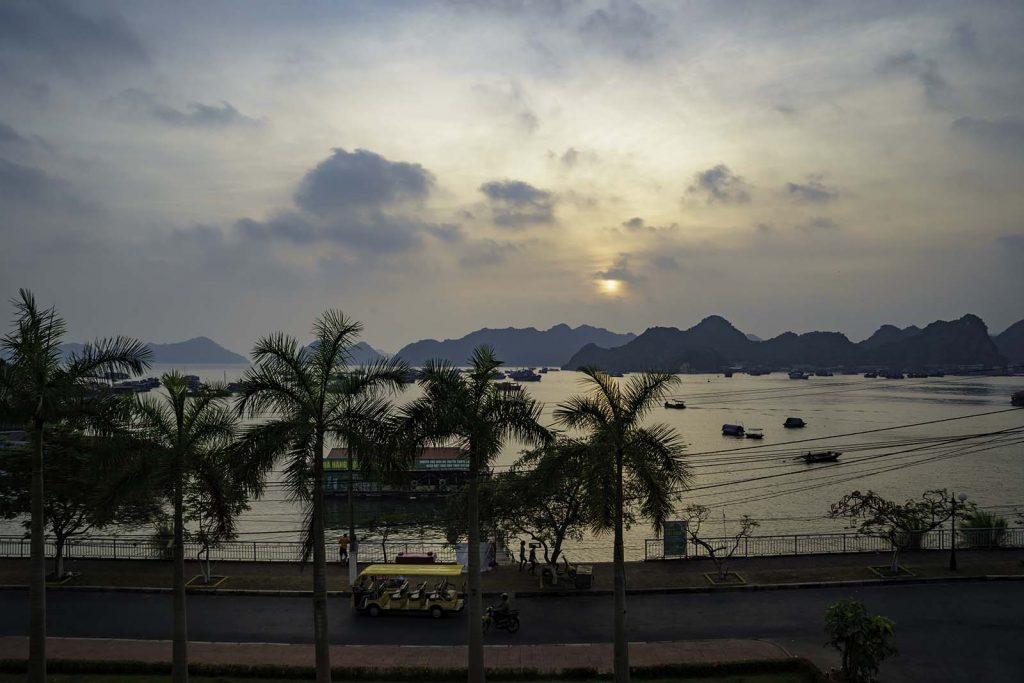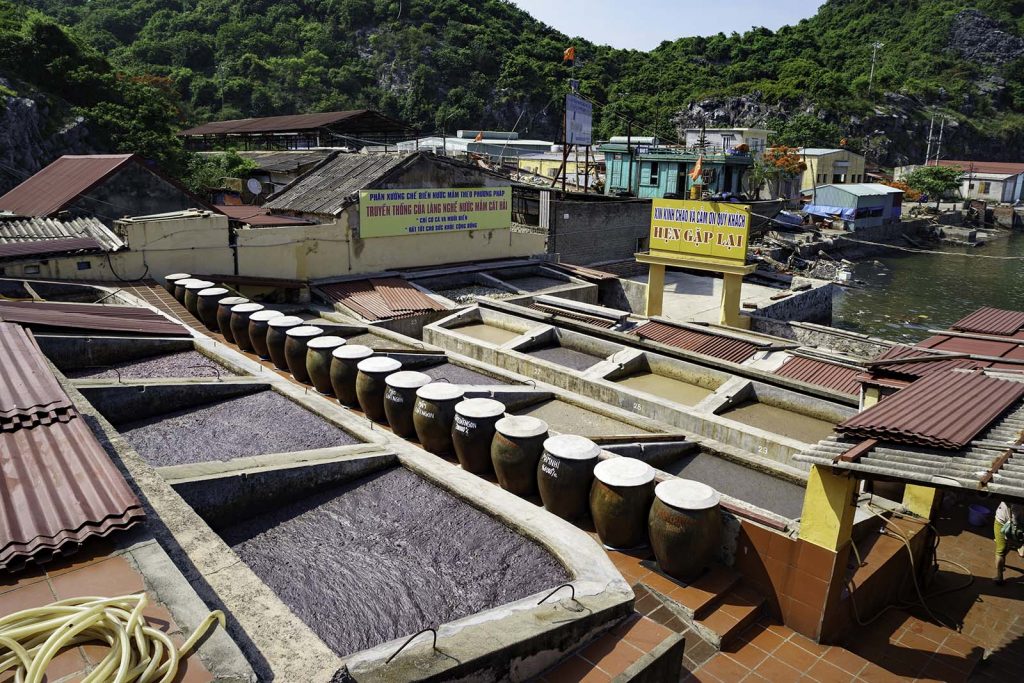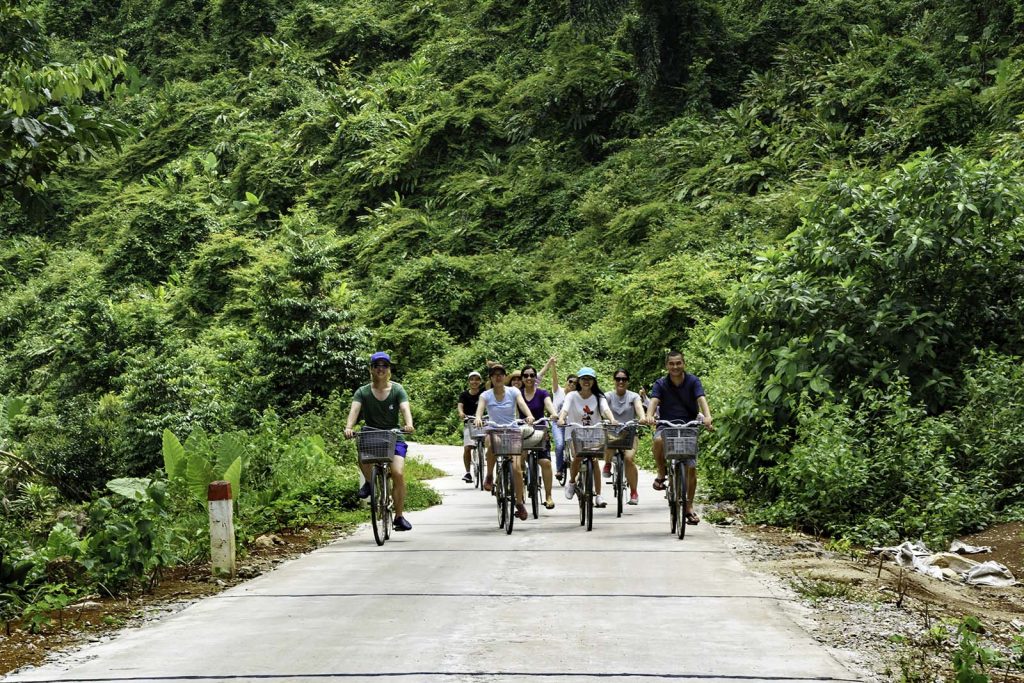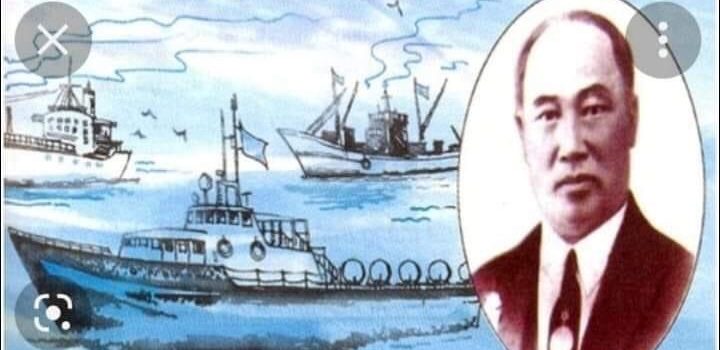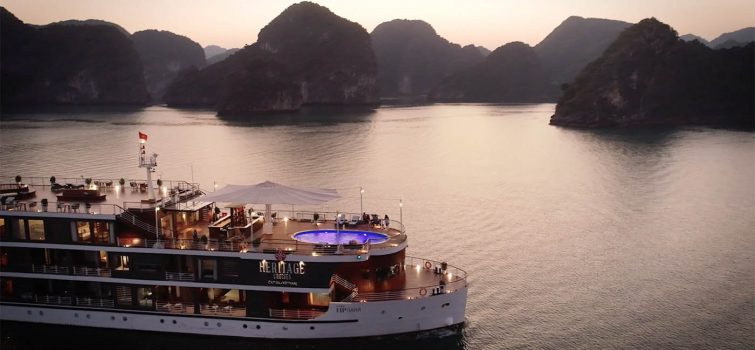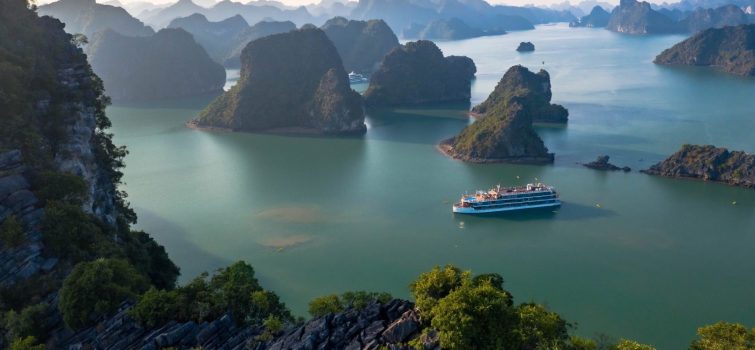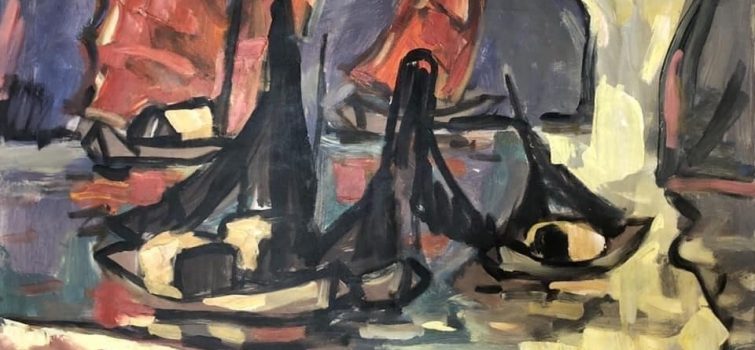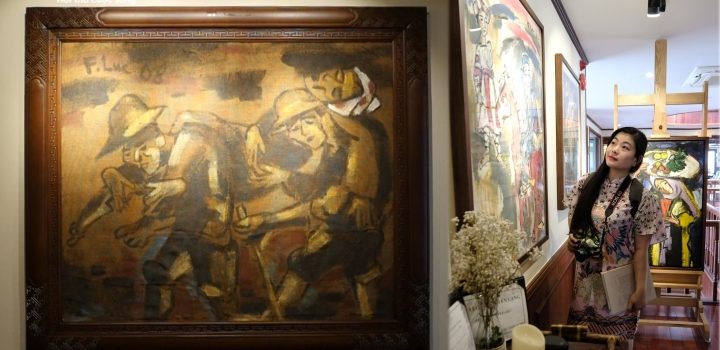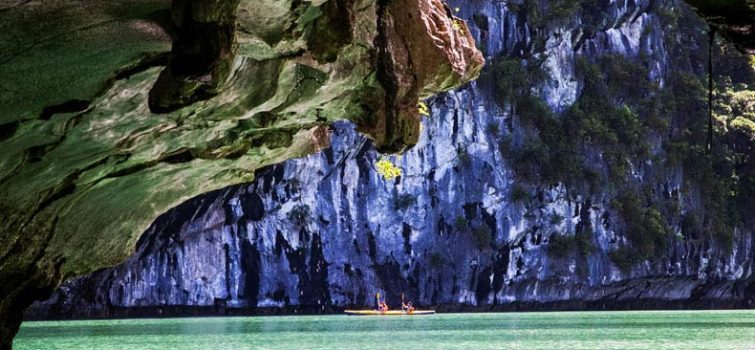Discovering Viet Hai: A Journey Through Time and Nature
Viet Hai, a remote village nestled in the heart of Northern Vietnam’s spectacular karst landscape, offers a compelling story of transformation and the enduring spirit of its people. As a long-time friend and business partner of Quyen, a local entrepreneur, I’ve witnessed firsthand the village’s evolution from a quiet agricultural community to a bustling hub of eco-tourism.
Quyen, whose life changed with the advent of tourism, runs a restaurant and bike rental service that caters to both the locals and visitors. This shift from traditional rice cultivation to tourism has brought new opportunities to the 80 households of Viet Hai, intertwining their destinies with the rhythms of the sea and the whispers of the mountain.
Embracing Slow Tourism
Instead of the usual quick visits, I chose to immerse myself fully in the rhythms of Viet Hai by staying at Lan Homestay. Located near Quyen’s restaurant, this rustic but comfortable accommodation is surrounded by a lush garden, offering a serene retreat from the bustle of daily life. This decision to experience slow tourism allowed me to connect more deeply with the village and its surroundings.
A Trek to Remember
One morning, filled with anticipation, Quyen and I embarked on a challenging trek to the Cat Ba National Park headquarters and onward to explore the historic Tien Duc Cave. It had been nearly a decade since Quyen last took this path, and he was eager to revisit it with me. Starting at 8 AM, equipped with sturdy shoes, insect repellent, and snacks, we began our 9 km journey across the park’s longest trail.
The trek was both a physical and sensory experience. We paid 80,000 VND for our entrance, a small price for access to one of Vietnam’s largest parks. As we walked, we absorbed the sights and sounds of the rainforest—each step a deeper dive into a world where nature dictates the pace and humans are mere guests.
Lessons from the Past
At Tien Duc Cave, Quyen shared stories of the villagers’ lives during the turbulent years of the Vietnam War. The cave, which once served as a shelter for the entire community, still bore marks of its past, with kitchen areas, tables, and beds etched into its walls. This visit wasn’t just a physical journey but a passage through time, connecting us to the resilience of those who once called this cave their temporary home.
The Karst Museum of Earth
The trek also offered breathtaking views of the surrounding karst formations. These natural sculptures, shaped by millennia of erosion, stand as silent witnesses to the immense geological and historical processes that have shaped this land. The jagged peaks and lush valleys told stories of ancient seas and the relentless force of nature carving out a landscape of awe-inspiring beauty.
Encounters and Reflections
Our return journey was marked by encounters with fellow trekkers, including a French couple exploring Vietnam’s rich natural heritage. These brief exchanges, filled with stories and laughter, underscored the universal appeal of Viet Hai and its ability to connect people from all walks of life.
As we concluded our trek and made our way back to civilization, the experiences of the day lingered in my mind. Viet Hai, with its compelling blend of history, culture, and natural beauty, offers more than just a getaway. It is a testament to the enduring human spirit and the transformative power of nature, inviting all who visit to not just see but feel, learn, and grow.
This journey through Viet Hai was more than just a visit; it was a profound engagement with a place that continues to evolve while respecting and preserving its past. It is a reminder that in the quietest corners of the world, we can find the most resonant stories waiting to be discovered.
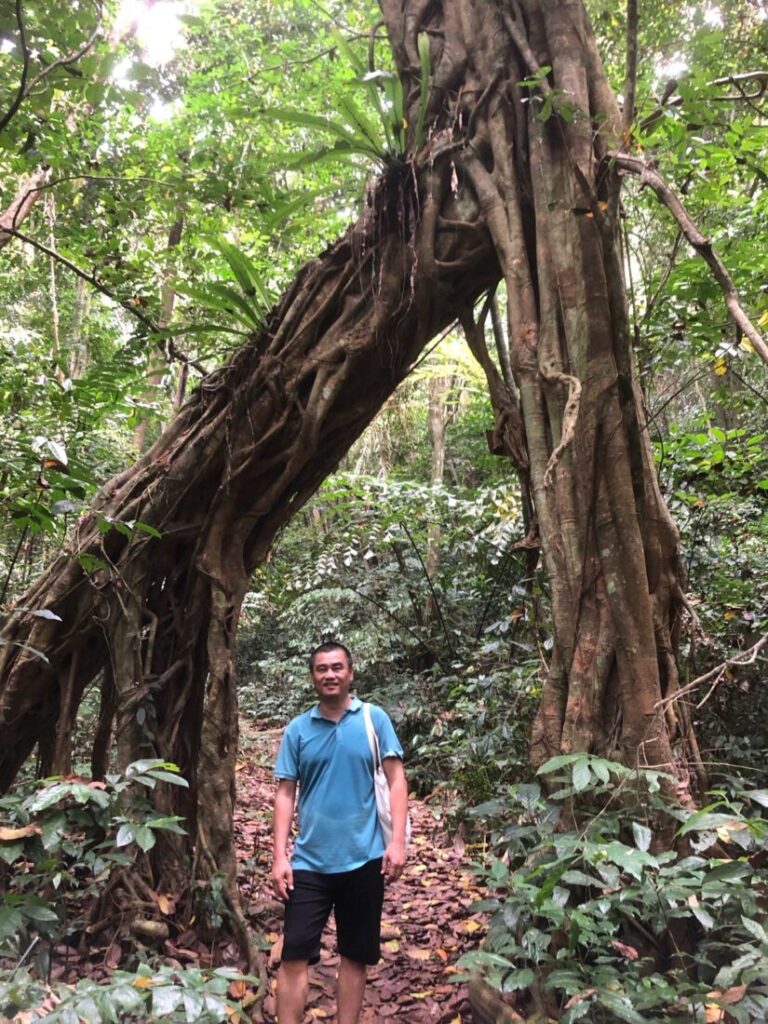
Dr. Pham Ha is the Chairman and CEO of LuxGroup (https://www.luxgroup.vn), a conglomerate of prestigious companies and a leading expert in the luxury tourism industry. Besides his business activities, he is also passionate about collecting paintings, antiques, writing about branding, economics, business management, and books on cultural heritage, history, and art.
Cat Ba Archipelago: Vietnam’s Hidden Gem in the Gulf of Tonkin now UNESCO World Heritage Listed Site
Cat Ba Archipelago: Vietnam’s Hidden Gem in the Gulf of Tonkin now UNESCO World Heritage Listed Site
An enchanting destination boasting pristine beaches, secluded lagoons, coves, tropical forests, and lakes invites you to explore the ideal spots for kayaking, biking, and secluded getaways.
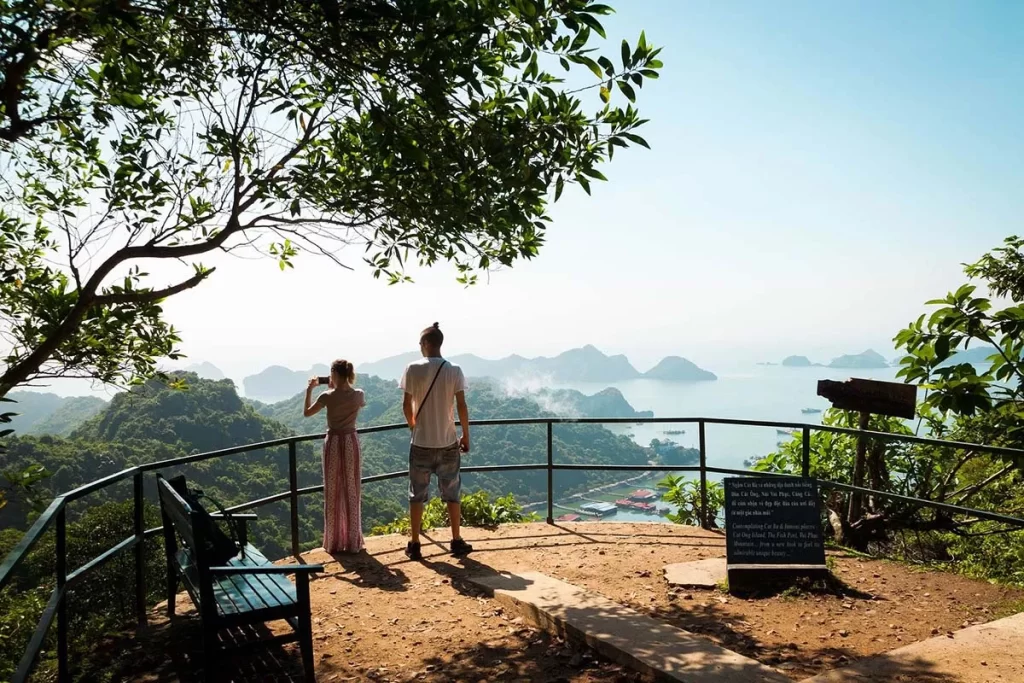
CANNON FORT
Depart from Cat Ba Town towards the well-marked entrance of Cannon Fort, just 15 minutes away. Enjoy a leisurely 20-minute stroll to the fort, where narrow passageways lead to underground tunnels and rooms once utilized for storage or as sleeping quarters.
The fort still showcases gun emplacements and massive guns, offering incredible views across the island and sea. One side reveals green-clad limestone karsts stretching into the distance, while the other side features colorful fishing boats, beaches, and the town itself.
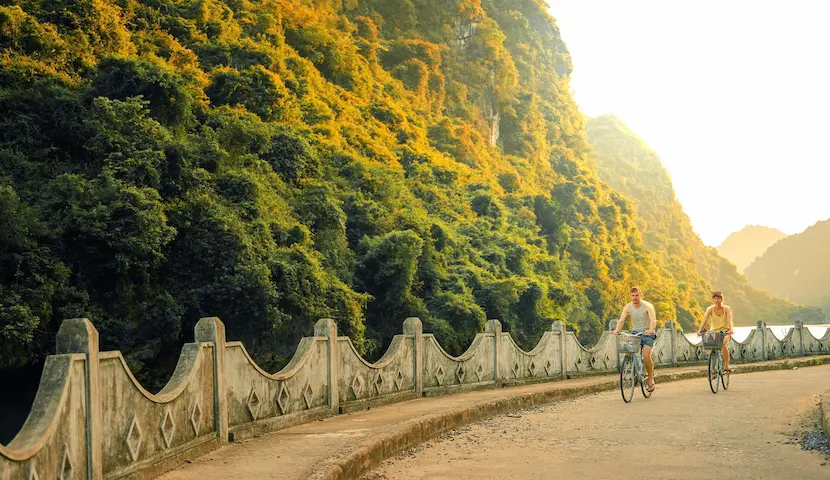
VIET HAI VILLAGE
No trip to Cat Ba is complete without a visit, or even an overnight stay, in Viet Hai village. Nestled in a valley with towering mountains as a backdrop, Viet Hai remains a peaceful enclave despite the island’s growing popularity.
Locals reside in thatched huts and primarily sustain themselves through fishing and farming, with only a handful catering to tourists. Access Viet Hai via a guided trek or cycle ride, passing by Ech (Frog) Lake, the island’s largest lake, or opt for a one-hour boat trip from Cat Ba Town followed by a 45-minute walk (or a short ride by electric car) to the village.
Verdant green paddies line the valley floor, where locals can be seen carrying water and produce on shoulder poles. Experience home-stays or stay in a modest bungalow resort, where the soothing chorus of frogs fills the night air with tranquility.
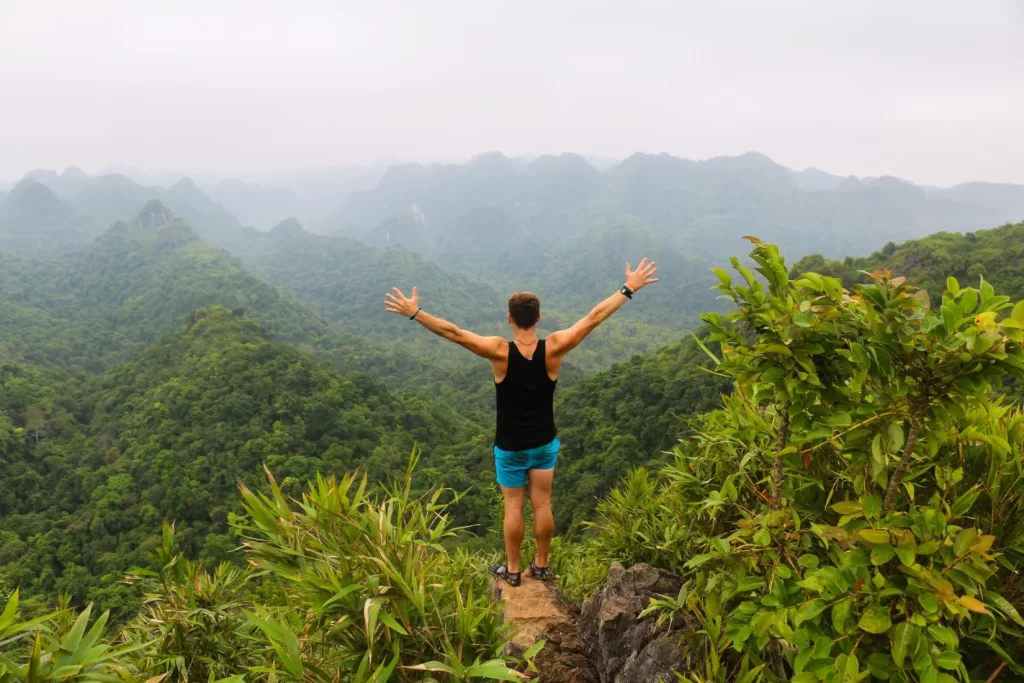
CAT BA NATIONAL PARK
Established in 1986, Cat Ba National Park sprawls across 9800 hectares of forest and 5400 hectares of marine habitat. Its distinctive limestone mountain range boasts an average height of 150 meters above sea level, with the highest peak, Cao Vong, reaching 322 meters.
Adjacent to the mountains lie white sand dunes, freshwater lakes, and mangrove forests. Enjoy pleasant weather year-round, with an average temperature of 23°C and a dry season from November to April. The park harbors Vietnam’s largest primeval tropical forest, housing hundreds of plant species, including various rare trees requiring protection.
Additionally, the park shelters endangered mammals such as the golden-headed langur, whose population has dwindled due to intense hunting. Cat Ba island lies along a major migration route for waterfowl, attracting around 70 bird species, including hawks, hornbills, and cuckoos.
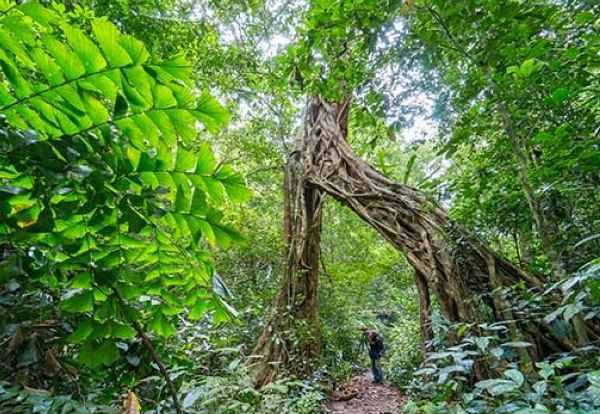
Flora
Tropical moist evergreen forest dominates the park, hosting over 745 flora species from 123 families, including approximately 300 medicinal plant species. Visitors marvel at the rich floral biodiversity, which includes endangered plants, ancient trees, moss, lichen, and creepers.
The park’s habitats, including fringe coral reefs, mangrove forests, and tropical limestone forests, are deemed regionally significant and face threats from encroachment.
Recognized as a World Biosphere Reserve in 2004, Cat Ba strives to protect these vital habitats.
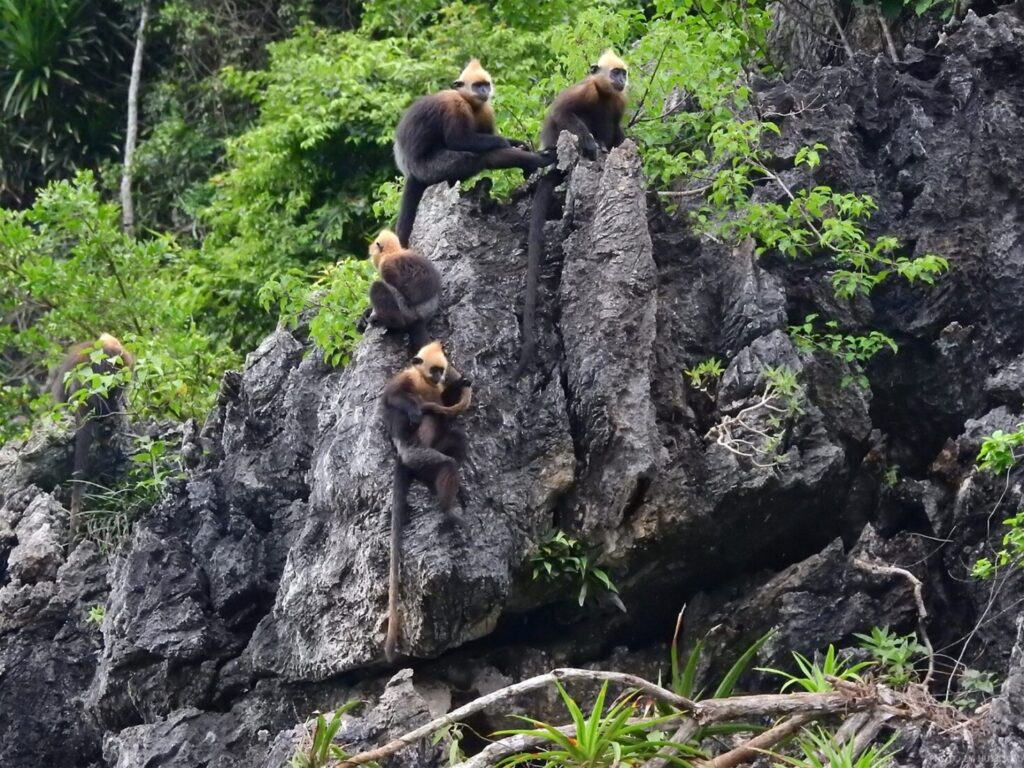
Fauna
Cat Ba National Park teems with wildlife, boasting over 20 reptile and amphibian species and 32 mammal species, including the golden-headed langur, a unique primate found solely on Cat Ba island. Living in small groups in remote areas of the island, the golden-headed langur symbolizes the park’s ecological importance.
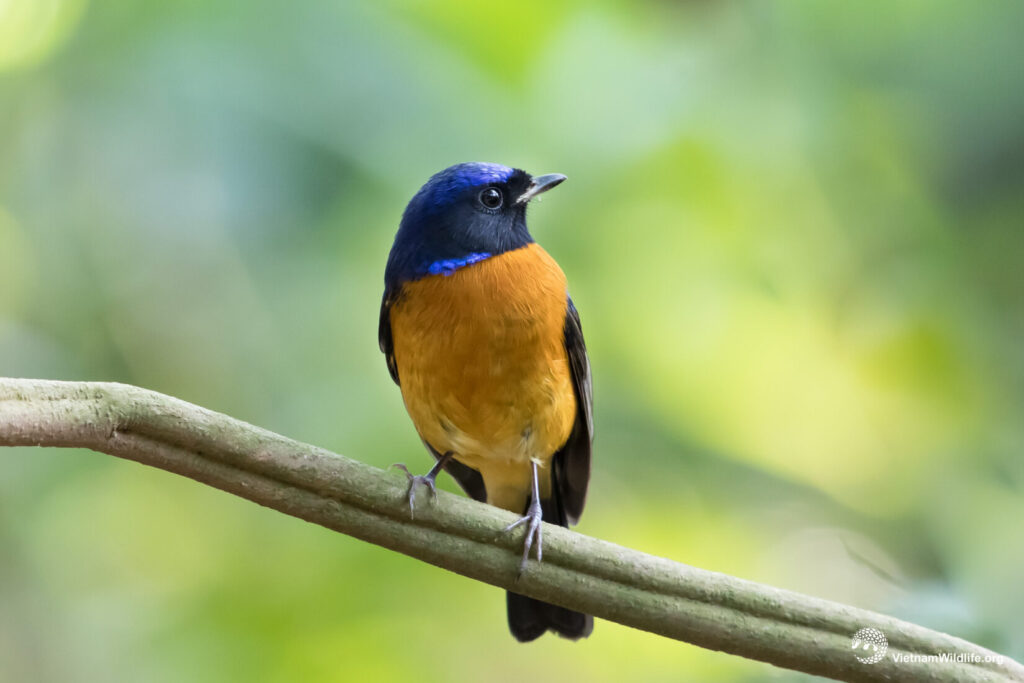
Birds
As a haven for diverse bird species, Cat Ba lies on a major migration route for waterfowl, attracting 70 different bird species. Visitors can easily spot kingfishers, sunbirds, and magpies, while deeper in the forest, the majestic great hornbill and pied hornbill can be observed in pairs or alone during the early morning or late evening.

Bats
Various insect-eating bats inhabit the park’s caves, with Trung Trang Cave being the most accessible. Visitors are encouraged to maintain quietude to avoid disturbing the bats’ habitat.
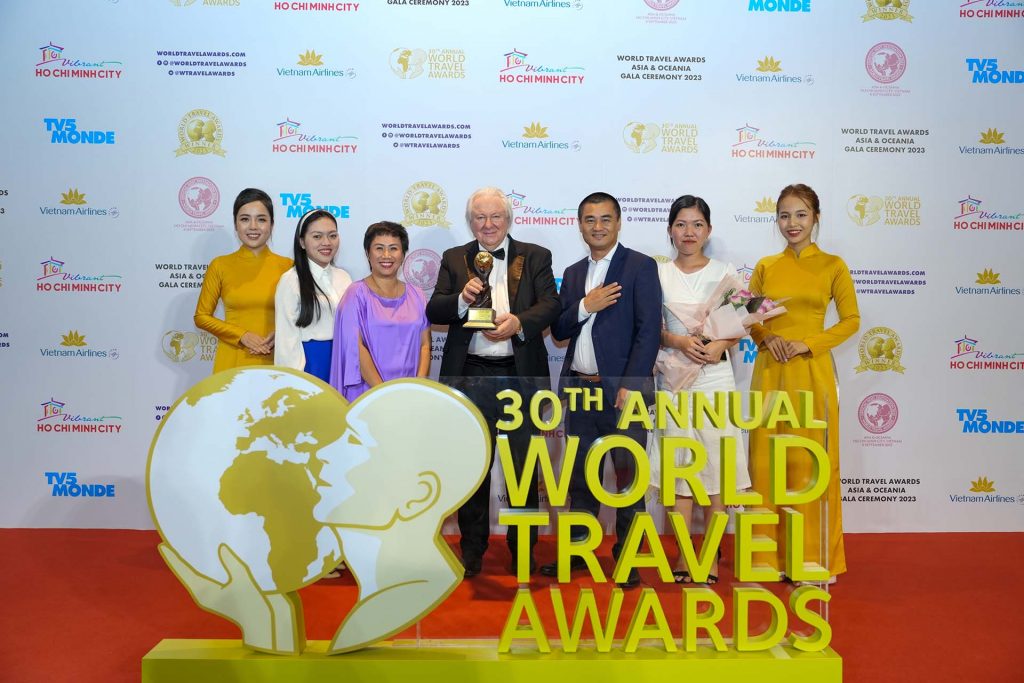
About Lux Cruises Group
Since its inception in 2014, Lux Cruises Group has set a standard in luxury and innovative travel. With an impressive fleet under the Emperor Cruises and Heritage Cruises brands, it explores Vietnam’s most iconic bays and archipelagos. Inspired by the legacy of Bach Thai Buoi, the “King of Ships,” Heritage Cruises offers an intimate voyage through the Gulf of Tonkin, immersing travelers in the rich tapestry of Vietnam’s culture, history, and natural splendor.
Discover, Explore, Experience Lan Ha Bay, One of the Most Beautiful Bays in the World.
Dark and bright cave
Overview
Dark and Bright Cave lie in the bordering area between Lan Ha Bay and Halong Bay, this area is located in the protected area of Cat Ba Biosphere Reserve. Coming to Dark and Bright Cave, tourists will be indulged in nature with the blue water and fresh air. The best way to admire the majestic foundation of the cave is to go kayaking or row bamboo boats. Inside Dark and Bright Cave, there are a lot of emulsions and stalactites with different shapes. This is also a safe place for cruises to anchor and provide shelter for fishermen in the rainy season. Adventuring along Dark and Bright Cave, visitors will be overwhelmed by the poetic, lyrical and pristine beauty that Mother Nature has endowed this destination.
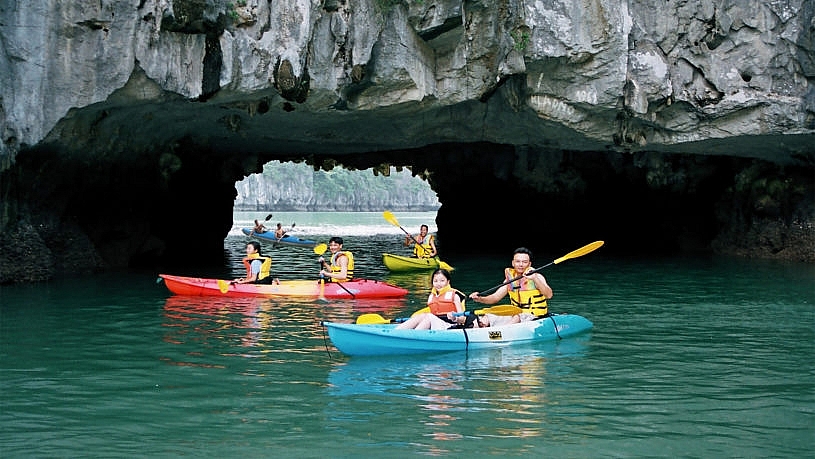
About Dark and Bright Cave Halong Bay
Dark Cave and Bright Cave are underwater ones, so the formation of these caves is different from other dry caves. Thus, Dark Cave and Bright Cave possess outstanding and distinguishing beauty. In the process of geological activities in Halong Bay, there are three types of caves which were formed by the impact of water on the karst topography. They are the ancient underground cave, Carxto cave, and frog’s jaw cave. Dark Cave and Bright Cave are frog’s jaw caves, while the cave floor is under the sea, the cave ceiling is beyond the water. With the unique topography and tectonics, the caves are only accessible by boat.
Things to do in Dark and Bright Cave Halong Bay
Tourists coming to Dark and Bright Cave have plentiful interesting options. You can choose to participate in many water activities such as: go kayaking to explore the beauty of the magnificent scenery, sit and sunbathe on the beach or swim and snorkel to discover the marine life.
Dark and Bright Cave is an ideal destination for those who are keen on kayaking and exploring nature. Kayaking is the best way to explore Dark and Bright Cave. With the kayak, visitors can get closer to the foot of the mountain, discover the beauty of nature, clearly see the erosion of water and waves into the limestone cliffs. When rowing into the caves, you are sure to be overwhelmed by the miraculous stalactites on the ceiling and cave walls. This is also a rare chance for you to capture memorable beautiful photos of the majestic Halong Bay.
Go through Bright cave, tourists will come to a lovely valley surrounded by spectacular mountain ranges. This setting gives travellers a feeling of being lost in Heaven. It is such a wonderful experience to sit on the kayak and slowly watch the scenery, breath in the fresh air and feel the harmony among the sea, mountain and sky. You will certainly be happy and full of vitality to get away from your bustling and busy life. Dark and Bright Cave is an ideal place for you which combine the beauty of nature with many sports and activities for tourists to enjoy.
Three Peaches Islet
Overview
Ba Trai Dao Islet is cluster of three small limestone mountains, more than 20 meters height, looking like three peaches rising from the water. This is also one of the most famous and beautiful beaches in Halong Bay. Three Peaches Beach shapes like a bow with smooth long white sand and becomes popular among tourists for its unspoiled, charming splendor.
About Ba Trai Dao Islet (Also known as Three Peaches Islet)
A tearful love story about Ba Trai Dao Islet
Legend has it that: Once upon a time, there was a fairy goddess who came to visit Halong Bay, she came to this place and she fell in love with a local poor fisherman. Their love grew stronger that she wanted he lived an immortal life with her forever. In order to do so, she stole three peaches from heaven garden for him. Jade Emperor knew about that and got very angry with her. He turned three peaches into three stone islands to imprison the man and forced the fairy goddess to return to heaven… Nowadays, Ba Trai Dao Islet has become an interesting destination for those who like pristine nature and adventure.
Splendid natural beauty
Come to Ba Trai Dao Islet, you can immerse in the clear blue water, enjoy the beautiful white sand. In sunny days, the water is crystal to see the bottom and ideal to snorkel for watching aquatic life. The beach is surrounded by rocky mountains, so there are no big winds and waves, which is very safe for small children. The cliffs above the beach create exotic shapes offering many photo opportunities for visitors. Moreover, Ba Trai Dao Islet provides an abundance of places for plants to grow and animals to live, creating a very lively natural landscape.
Things to do in Ba Trai Dao Islet
Ba Trai Dao Islet is located in a more secluded part of Halong Bay, there are not too many tourists passing through, so it still retains many wild and rustic features. The most popular activity here is kayaking, almost tour itineraries include kayak for your journey. You can row through the cliff corners, among imposing mountains to explore clear hidden lagoons, varied indigenous flora species, and animals living on limestone islets.
Tourists also enjoy being immersed in the water, swimming and relaxing, sunbathing on the white sand. However, if the tide rise, the whole beach will be under the water. You can only swim and enjoy the beach for 2-3 hours a day, so you should check the tides schedule before going there. Anyway, this is a not-to-miss attraction when coming to Halong Bay. You should bring the camera to capture the beautiful scenery and splendid natural splendor of Ba Trai Dao Islets.
All year round, thousands of tourists come here to sightsee and admire the beauty that Mother Nature has given to this place. Nowadays, Ba Trai Dao Islets is one of the most amazing destinations of Halong Bay that all tourists want to discover and explore.
Cua Van Village
Overview
Cua Van Floating Fishing Village is located in Hung Thang commune (Halong city), about 20 km away from Halong Tourist Port. This area is surrounded by majestic limestone mountains, so the water is calm with no big waves, which is ideal for anchorage and people to cluster into a floating village. The village is about tens kilometers far away from the shore, lying alongside stone cliffs.
About Cua Van Floating Fishing Village
The serene beauty of Cua Van Floating Fishing Village
The prestigious travel magazine Journeyetc.com acknowledged Cua Van Floating Fishing Village as one of 16 most beautiful ancient villages in the world due to its ancient charm, beautiful scenery and well-preserved traditional culture. Cua Van Floating Fishing Village lies beneath majestic limestone mountains, floats on the ocean and blends perfectly with natural surroundings. The scenery is extremely romantic and leaves a distinct impression in the hearts of tourists. Cua Van Floating Fishing Village is one of only a few places that still retain the original unspoiled splendor. Local people routines have not disturbed by the bustling pace of modern life.
Floating life of local people
Cua Van Floating Fishing Village originates from two ancient villages named Giang Voong and Truc Vong. Residents of the village have been around for a very long time. Nowadays, there are more than 300 households with over 750 inhabitants live mainly by fishing and fish farming in Cua Van Floating Fishing Village. Generations of fishermen set up houses, live and pass down the traditional floating lifestyle to their children.
Cua Van Floating Fishing Village attracts tourist, not only because the beautiful natural scenery is outstanding, but also local residents are aware of keeping their living environment green and clean. At Cua Van, all floating houses are very tidy, people take turns to collect trash and garbage on the sea every day. They save fresh water, reduce the amount of waste in the marine environment. Journeyetc.com highly appreciates the preserving consciousness of the people. Cua Van is well worth a visit when traveling to Halong Bay.
Things to do in Cua Van Floating Fishing Village
Coming to Cua Van Floating Fishing Village, visitors not only have a chance to see the natural scenery, learn about the cultural life of the fishermen, but visitors can also sail around the village and take part in many interesting activities in local daily life.
Under the instructions of local villagers, visitors can spread the catching net, fish squids, and enjoy the seafood that they have caught. Especially on festive occasions or wedding ceremonies, visitors can have an unforgettable experience to enjoy endemic folk songs of local fishermen such as traditional love songs, ferry songs (imitating rowing rhythms).
Moreover, your journey will be filled with exciting adventurous activities. It is an interesting option for tourist to explore Tien Ong Cave nearby. Ba Ham Lake is also an attractive destination for activities such as caving, kayaking, and swimming. Almost visitor will have a good time to row bamboo boats to discover around the village, chat with locals, fish squids and enjoy the marine beautiful tranquil scenery. Cua Van Fishing Village becomes one of the most charming destinations that you want to visit in your lifetime trip to Halong Bay.
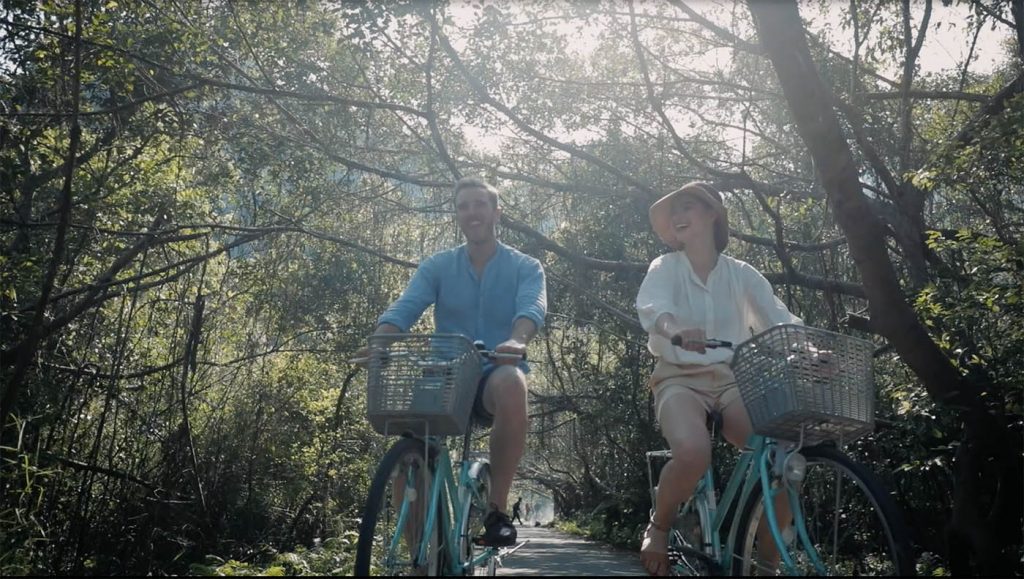
Viet Hai Village
Overview
Viet Hai Village is a small village, located in the core of Cat Ba National Park in Cat Hai Island district, Hai Phong. Due to its remote location, there are not many indigenous peoples living there. However, Viet Hai Village has recently become an attractive destination for domestic and foreign tourists, especially for trekkers and bikers.
How to get to Viet Hai Village Cat Ba
Travellers first have to arrive at Beo Port in Cat Ba Island, from there, you take the ferry or boat to Viet Hai Port. Viet Hai Village is about 5 km from the port, you can walk, rent bicycles, take trams to get to the village. Trams can carry up to 12 passengers per trip and the monolithic road to the village has been concretised for easier transportation.
Local life in harmony with nature
Viet Hai Village has over 70 roofs. Most of which are traditionally made from bamboos, clay, and straw. To build an old-style house, they first mix mud and straw into a dense mixture, then cover the mixture over bamboo sticks, leave the mixture to condense to make hard walls. The roof is covered with thick layers of grass. This mud-walled cottage is a typical image of Vietnamese Northern countryside, that only a few ancient villages still retain this unique type of house.
The tranquil and peaceful life in Viet Hai contrasts with the bustling noisy of other tourist attractions. It is good to have some quiet moments, just to relax and get away in a remote area lying in the middle of deep valleys, geographically divided by the ocean that only a few people have ever set foot on.
Community-based tourism in Viet Hai Village
Viet Hai Village has been developing as a community-based ecotourism destination that attracts many travellers. Especially foreign tourists who want to experience and explore rustic village life and wide nature. Community-based tourism is a focus to support the livelihoods of local people, helps them to earn more income, integrates them into the outside world. Despite the lack of conditions, Viet Hai also has many advantages in terms of natural landscape and distinctive cultural characteristics to attract tourists.
Activities in Viet Hai Village for Travellers
Viet Hai villagers are very sensitive when providing services. They send people to tourist centers such as Hanoi, Ho Chi Minh City to learn about community-based tourism and how to apply to their condition. Besides their work on the field, they also work as local tour guides, hosts, and drivers for tourists. Local people supply and directly serve every need of visitors. Some families operate homestay services and set up small eateries providing local specialties. In Viet Hai Village, travellers can admire the simple rustic beauty when walking through the green rice fields, cycling along winding countryside roads, breathing fresh air and feeling the serenity in every corner of this peaceful village. It is such a memorable experience to enjoy the scenery of mountains, forests, and ocean, all in one place.
Years recently, Viet Hai Village has welcomed thousands of visitors to visit and experience the life and activities of villagers. With the extensive participation of locals in organising activities and supplying services, tourism in Viet Hai becomes a unique, attractive and sustainable tourism product.
Lan Ha Bay
Overview
Lan Ha Bay is located in the southeast of Cat Ba Town, adjacent to Halong Bay. This is a peaceful gulf-shaped bay with about 400 islets and islands in various sizes creating a magnificent picture depicting the fairylike seascape. All the big and small islands in Lan Ha Bay are covered with green trees and rich organism, which triggers the curious mind of worldwide travelers.
About Lan Ha Bay
Lan Ha Bay possesses a high density of limestone mountains which are primitive, peaceful and precious in biological value. There are a lot of pristine mountains with many shapes depending on visitors’ imagination such as Wooden Shoe Islet, Bat Islet… Lan Ha Bay is also the cradle of gulfs and caves, which have not been discovered yet. Besides, travelers are stunned by stalactite grottoes with distinguishing features such as Ham Rong Cave, Do Cung Cave, Ca Cave…
Compared to Halong Bay, Lan Ha Bay is more charmingly romantic with 139 golden-sand beaches, lovely and desolate beaches inviting visitors to explore. Many sandy beaches stretch between rocky mountains offering quietness with no big waves, which are really the ideal places for swimmers. And under the turquoise water in Van Boi Beach, Van Ha Beach, Sen Island, Monkey Island, travelers can also get snorkel and dive to appreciate the colorful coral reefs and many aquatic creatures.
Da Chong Islet
Ho Ba Ham Islet
Overview
Ho Ba Ham Islet lies on Dau Be Island in the southernmost part of Halong Bay, 25 km away from the tourist port. Ho Ba Ham Islet is in the middle of a narrow rectangular sea, surrounded by high upright limestone mountains. Under the foot of the mountains, there are three water caves. To go from one cave to another, visitors have to sail through tunnels with low domes. From the ceilings, many stalactites hang down creating beautiful natural scenery.
About Ho Ba Ham Islet
Natural characteristics of Ho Ba Ham Islet
Ho Ba Ham Islet consists of three large lakes interconnected by a narrow winding tunnel. This tunnel is actually the upper part of a water cave, a typical form of limestone karst that was eroded by water, waves, and tides. Each cluster of colorful stalactites drops from the tunnel ceiling with strange shapes. On the islet, lots of evergreen plants like orchids, banyan trees, palms are growing to create a favorable living environment for endemic animal species of Halong Bay such as golden monkeys, flying squirrels, bats, rare birds. Under the blue water of three lakes, there is the vibrant life of many marine species.
From the entrance, visitors will go through a tunnel into the first lake. Inside the tunnel, stalactites in multi colors look like a bunch of fibrous roots. Going about 100 meters further, there is a light beam from the ceiling of the tunnel, where you will see many kinds of orchids clinging to the cliffs, clusters of evergreen trees in rocky mountains. Then, the second lake opens and has an ancient star fruit tree growing on the southeast cliff that gives fruit all year round. Passing through a cavern for about 5 minutes from there, you will reach the third lake. This is a peaceful home to many kinds of rare birds and butterflies.
The ecological diversity of Ho Ba Ham Islet
Ho Ba Ham Islet still retain the wild and mysterious nature without the impact of human. With ideal ecological conditions, Ba Ham Lake is a habitat of typical ecosystem. There are many endemic plant species of tropical forests growing on the cliffs such as azaleas, ferns, and palm trees. Squirrels, monkeys, birds also choose this place as their home and often go out to eat, so visitors can watch the animals like in a natural zoo. The water of three lakes is crystal clear to see the fish swimming around and special aquatic systems at the bottom.
Things to do in Ho Ba Ham Islet
With many great advantages, Ho Ba Ham Islet is gradually becoming one of the most attractive destinations in Halong Bay. To explore the beauty of Ho Ba Ham Islet, visitors can row bamboo boats or kayaks to go further into the lakes. It is also an ideal place for swimmers and snorkelers. Most of cruising itineraries are considered Ho Ba Ham Islet as a highlight of the trip. You should choose the overnight cruise to have a good amount of time to visit this interesting destination. It is advisable to rent a kayak to truly enjoy a moment of your own and admire the charming beauty of Ho Ba Ham Islet.
Cat ba Island
Overview
Cat Ba Island is located only 30km from Hai Phong city center and 25km from Ha Long City. From Hai Phong, it is very convenient for tourists to take a ferry or speedboat to visit Cat Ba. Or you can enjoy cruising from harbors in Quang Ninh to have an exciting journey through the Natural Wonder Halong Bay to reach Cat Ba Island.
About Cat Ba Island
Best time to travel to Cat Ba Island
Cat Ba Island has a favorable weather condition, so visitors can travel Cat Ba all year round. In any season at any time, Cat Ba has its unique charm. While domestic tourists often go there in the summer, international tourists mainly visit Cat Ba Island from November to March.
High season in Cat Ba is the summer time from May to August, therefore, if you can arrange, you should go before or after the high season, or you should go in the weekdays to avoid the crowds.
Cat Ba’s natural charm
You will feel like to enter a new world when setting foot on Cat Ba Island. It is very comfortable and refreshing to travel on the road through the dense green forest to reach the island heart. The mountain passes are quite challenging for the adventurous tourists. Admiring the spectacular sceneries on the road, you will understand why biking tour across the island is the first choice of foreign guests.
How to get to Cat Ba Island from Hanoi
- BUS from Hanoi to Cat Ba Island
The fastest and cheap way how to get from Hanoi to Cat Ba Island by bus. Bus is going over the longest sea-crossing bridge in Southeast Asia – Tan Vu – Lach Huyen (opened in September 2017) and is going directly to the Cat Ba town on the island over the Cat Hai Island. A short boat transfer of bus (10 minutes) from the Got Port (Bến phà Gót) to the Cái Viềng port.
Bus is going over the longest sea-crossing bridge in Southeast Asia – Tan Vu – Lach Huyen (opened in September 2017)
- TRAIN + SPEEDBOAT from Hanoi to Cat Ba Island
First let’s cover the details for taking a train and then a speedboat from Hanoi to Cat Ba via Hai Phong. Hanoi Railway Station is pretty central and only around a 20 minute walk from the centre of the old quarter.
From here you will take a train into Ga Hải Phòng Railway Station. This part of this route option from Hanoi to Cat Ba will take around 2 hours 45 minutes.
- Speedboat from Hai Phong (Pha Binh port) to Cat Ba Island
- BUS + SPEEDBOAT from Hanoi to Cat Ba Island
Bus from Hanoi to Hai Phong
This last option for getting from Hanoi to Cat Ba involves first taking a bus from Hanoi to Hai Phong and the speedboat option from Hai Phong to Cat Ba as detailed above in option 2.
- FLIGHT from Hanoi to Tuan Chau Island (Seaplane)
Swimming in Cat Ba Beaches
Things to do in Cat Ba Island
In Cat Ba, there are 3 most popular tourist beaches: Cat Co 1, 2 and 3, with clear water and near the town center. In particular, Cat Co 1 beach is larger and more favorable, with three sides surrounded by rocky mountains. Cat Co 2 and 3 are smaller but quite peaceful. The beaches are connected by a small path along the mountain.
Hiking
If you want to have a panoramic view of Cat Ba, you should hike the crest of 177m high Gun Fortress. It is not only a historical relic, which marked the brilliant achievements of the local people; this place also has an ideal location with 3 sides facing the ocean. What a spectacular location to just sit there while sipping coffee and watching the romantic sunset.
Kayaking
The best water sport to try in Cat Ba is to go kayaking. You are sure to be overwhelmed by the majestic landscape and seascape here.
Cat Ba National Park
Cat Ba National Park is one of the unique biosphere reserves recognized by UNESCO. This is a real paradise for those who love to explore nature and challenge themselves. The typical route is only about 1.8 km, while the longest crossing mountain to Viet Hai fishing village is about 16 km. You can see countless species of endemic species, luckily you can see the Cat Ba langur – the symbol of the island.
Halong Bay
Halong Bay is one of seven wonder in the world, with area is 1553 km2. Halong Bay consists of 1969 island and islet, most of which are limestones. specific feature of Ha Long Bay is the abundance of lakes inside the limestone islands. It was declared twice time by UNESCO in 1994 and 2011. The limestone in this bay has gone through 500 million years of formation in different conditions and environments. The evolution of the karst in this bay has taken 20 million years under the impact of the tropical wet climate. Ha Long Bay is home to 14 endemic floral species and 60 endemic faunal species.
HANOI: The former capital of French Indochina and now the heart of the nation
In autumn of 1010, Emperor Ly Thai To decided to move the capital of the kingdom to Dai La (Hanoi today) from Hoa Lu (present Ninh Binh). He was mindful that the place was an ideal location with many advantages for wet rice farming and traffic thanks to a number of waterways, especially the Red River, the backyard of Ba Vi mountain, promising the long-term prosperous development of a capital and a nation. After moving the capital and renaming it Thang Long, Ly Cong Uan ordered the construction of a citadel to protect the city. Since then, Thang Long has become the political, economic, and cultural center of the country.
When the Nguyen dynasty was established in 1802, Emperor Gia Long moved the capital to Hue. Thang Long was no longer the capital, its Chinese characters was changed from 昇龍 (“Rising dragon”) to 昇隆 (“Ascent and prosperity”), aiming to reduce the sentiment of Le Dynasty. Emperors of Vietnam usually used dragon (龍 long) as a symbol of their imperial strength, and power. In 1831, the Nguyen emperor Minh Mang renamed it Hanoi (河內, “Between Rivers” or “River Interior”). Hanoi was occupied by the French in 1873 and passed to them ten years later. As Hanoi, it was located in the protectorate of Tonkin and became the capital of French Indochina after 1887.
 The city was occupied by the Imperial Japanese in 1940 and liberated in 1945, when it briefly became the seat of the Viet Minh government after Ho Chi Minh proclaimed the independence of Vietnam. However, the French returned and reoccupied the city in 1946. After nine years of fighting between the French and Viet Minh forces, Hanoi became the capital of an independent North Vietnam in 1954. The French Army withdrew that year and the People’s Army of Vietnam and International Control Commission occupied the city under the terms of the 1954 Geneva Conference. Following the end of the Vietnam and US war, Hanoi became the capital of a reunified Vietnam when North and South Vietnam were reunited on 2 July 1976.
The city was occupied by the Imperial Japanese in 1940 and liberated in 1945, when it briefly became the seat of the Viet Minh government after Ho Chi Minh proclaimed the independence of Vietnam. However, the French returned and reoccupied the city in 1946. After nine years of fighting between the French and Viet Minh forces, Hanoi became the capital of an independent North Vietnam in 1954. The French Army withdrew that year and the People’s Army of Vietnam and International Control Commission occupied the city under the terms of the 1954 Geneva Conference. Following the end of the Vietnam and US war, Hanoi became the capital of a reunified Vietnam when North and South Vietnam were reunited on 2 July 1976.
Today, Hanoi is still a city of rivers, of which the Red River is the largest. For Hanoians, the Red River is not only a source of life, it is also a reflection of Vietnamese history and the capital city’s long prosperity. Heritage buildings such as churches, grand cathedrals, opera houses, clocks, colonial buildings, villas, museums, palaces, river ports, and iron bridges remain unchanged though some have disappeared. Many boulevards with French names have changed to Vietnamese names. Regrettably, the heritage street Bach Thai Buoi was changed to Nguyen Huu Huan alley in 1954 on the bank of Red River, but his former two-story office houses in Hang Muoi Street remain intact facing the clock with his former inland waterway port near Chuong Duong Bridge.
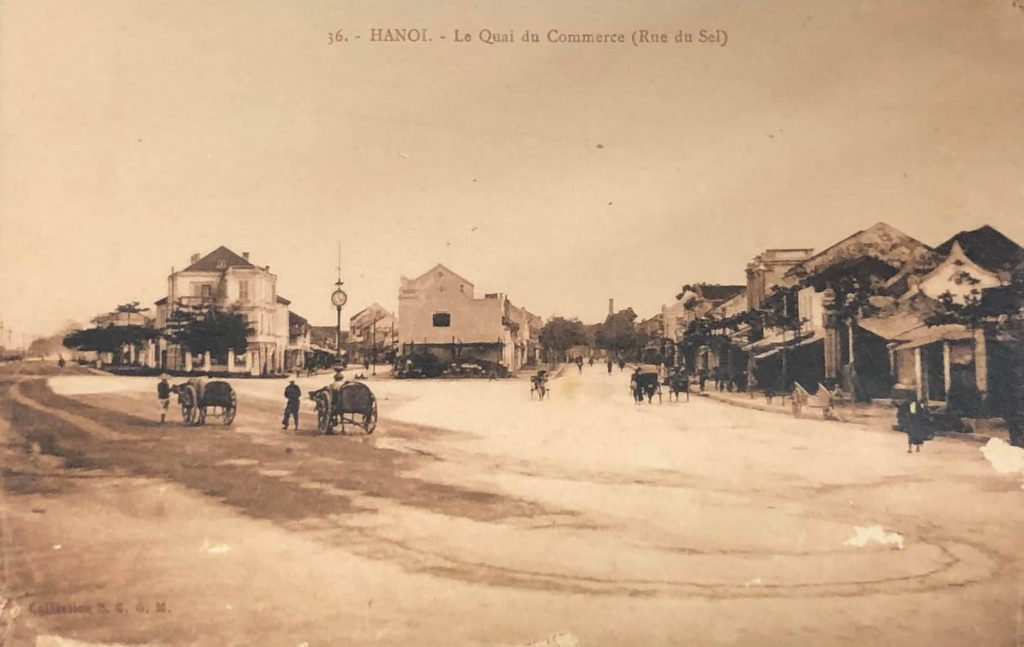 High-rise buildings are rare in this city which is striving to retain its character. Grand colonial buildings, tranquil lakes, and a maze of narrow streets provide intriguing contrasts. Hanoi is an elegant city with tranquil Hoan Kiem Lake (Grand Lac on postcards) at its heart. North of the lake are the bustling 36 guild streets of the Old Quarter, each street named after the trade that used to take place there. Hanoi is truly a city of contrasts with areas of wide boulevards and large colonial buildings, reflecting its period as a French Protectorate, and other areas truly Vietnamese with a muddle of narrow streets which bustle from dawn to dusk.
High-rise buildings are rare in this city which is striving to retain its character. Grand colonial buildings, tranquil lakes, and a maze of narrow streets provide intriguing contrasts. Hanoi is an elegant city with tranquil Hoan Kiem Lake (Grand Lac on postcards) at its heart. North of the lake are the bustling 36 guild streets of the Old Quarter, each street named after the trade that used to take place there. Hanoi is truly a city of contrasts with areas of wide boulevards and large colonial buildings, reflecting its period as a French Protectorate, and other areas truly Vietnamese with a muddle of narrow streets which bustle from dawn to dusk.
Similarly to the guilded age of Europe, “Hanoi’s 36 districts” is Vietnam’s version of the guild concept. In the past, as artisans moved to the capital city to do business, they gathered together in this area to share the resources and built communal houses and their temples. As a result, many of the streets were named after the crafts sold at that individual street. Pho Hang Muoi (Rue du Sel or Salt Street), Pho Hang Bun (Vermicelli), Pho Hang Ma (Paper Product), Pho Hang Bac (Silver), Pho Hang Non (palm-leaf conical hat), … are examples of the streets carrying the name of the products sold there. Explore my rich collection of postcards about Hanoi’s old guild streets and iconic buildings of the capital of Indochina and now the heart of Vietnam.
Best Boutique Cruise Line
Embark on a journey back in time to Vietnam in 1930s with Heritage Cruises Binh Chuan Cat Ba Archipelago boutique lifestyle cruise in Lan Ha Bay in Cat Ba Archipelago. Combining the classical charm of French Indochina with a sense of timeless chic that only the Lux Cruises can provide, the cruise is as much an art and heritage space as it is a 5 star cruise. Heritage Cruises Binh Chuan Cat Ba Archipelago invites guests to relive the romance of this bygone era in their boutique cruise which offers all the comforts of the 21st century.
The most luxurious cruise in Vietnam has many cultural features, bringing with it the stories of cultural and historical heritage, fine art, architecture, fashion, and the quintessence of Vietnamese cuisine. The yacht is newly built based on the Binh Chuan ship built by the ship king Bach Thai Buoi, the first Vietnamese to launch a ship from Hai Phong to Saigon. From the point of departure 100 years ago, today’s Heritage Cruises Binh Chuan takes travelers on a journey to discover Lan Ha Bay in style, a vast sea area with hundreds of islands, lagoons, and beaches, large and small, an experience recognized by the world. Channel 14 describes it “as beautiful as a dream” and Leonardo DiCaprio praises the ‘paradise’ beauty of Lan Ha Bay.
https://www.youtube.com/watch?v=45UNROguoNM&t
On the cruise, travelers can discover the authenticity of Lan Ha Bay, Binh Chuan Heritage Cruise will bring travelers into a traditional cultural space, the glorious legend of the intangible heritage, and enjoy the beauty of the natural heritage of Vietnam. Heritage Binh Chuan Cruise will bring the most authentic experiences with a minimum of 40 guests and a maximum of 60 passengers on a magnificent and sophisticated cruise operating in the Gulf of Tonkin. Savored travelers will immerse into the culture, history, art, and people of Vietnam when cruising on a unique cruise amidst natural wonders. On this heritage cruise, travel connoisseurs can go upstream of history and culture to learn the business story of “Vietnam’s king of ships” Bach Thai Buoi and the life of the “Vietnamese Picasso“, Pham Luc, through a rich collection of 100 of his works collected and introduced by the owner Pham Ha in various locations.
Heritage Binh Chuan received the most prestigious award, TripAdvisor 2022 Travelers’ Choice Awards “Best of The Best”. Luxury Lifestyle Awards 2020. Lux Cruises to expand the brand to Quy Nhon, Nha Trang, Phu Quoc in Kien Giang province, and Cat Ba archipelago in Hai Phong city, for unique yachting experiences in the coming year.” Start our first expeditions on the Gulf of Tonkin and further expand between Hanoi and Halong Bay on the Red River and its tributaries, along the coastline of Vietnam, on the Mekong River and to other Southeast Asia countries.
Cac-Ba
Many legends and mythologies surround the island’s name
From my vintage postcards of French Indochina, I treasure a rich collection about local life, people, landscape, townscapes and villages in the early 1930s, as well as some of the many legends and myths which have been handed down the generations.
The first is the legend of the name ‘Cac-Ba’, which means Island of women in Vietnamese, where, once upon a time the island used to be the realm of women who grew vegetables and supplied food to the men so that they could have the strength to fight off invaders.
Cat Ba island is also characterized by the Kim Giao tree (scientific name Nageia-fleury) whose origin is linked with an ancient legend. These species grow in Cat Ba National Park and the most notable characteristic of these species is that the wood changes color when it comes into contact with any toxic substance. Therefore, in the past, this kind of wood was often used to make chopstick for the king.
The legend surrounds a romantic love story between a talented man, Kim Ngan, and a beautiful princess, Giao Thuy. The man was poisoned by envious and sycophantic courtiers and died. The princess cried so much for her lover that she lay down by his tomb and died with grief. Afterwards, two trees grew from the tomb and local people named the species Kim Giao in their honor.
Cat Ba is the largest of the 366 islands, spanning over 260 km2, that comprise the Cat Ba Archipelago, which makes up the southeastern edge of Halong Bay, and is a new hotspot for cruises, cultural activities, heritage travelers, and holidaymakers.
A masterpiece in the natural wonder
A touch of heritage in the sanctuary of the senses
By Waseem Ahmed
Vietnam’s first boutique cruise brings heritage alive, only 90 minutes away from Hanoi. Heritage Cruises showcases the country’s art, history, culture and gastronomy in the Halong Bay region.
The cultural and artistic heritage, as well as the spirit of patriotism of the entrepreneur, Bach Thai Buoi, were the inspirations for the owner of Heritage Cruises as he planned thematic experiences that will awaken the senses of guests traveling deep into the heart of Halong Bay.
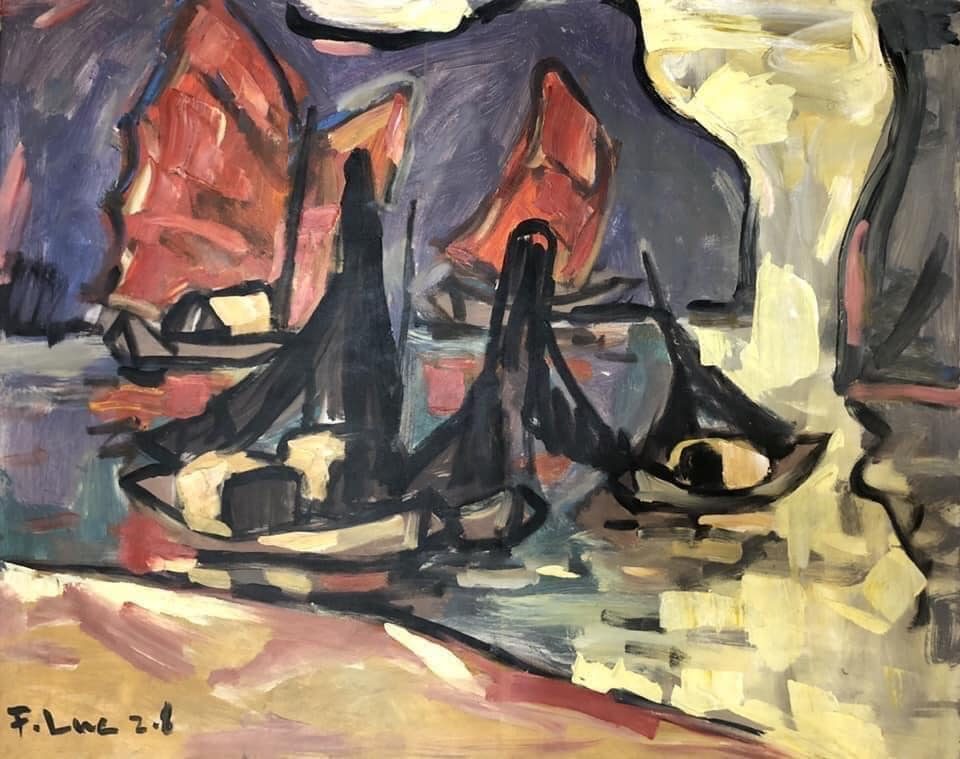
With its haute cuisine complemented by superior service, Heritage Cruises will shape the design of brand-new cruise ships and lead new boutique trends in Vietnam. Cruising is all about you and travel is about the destination, the experiences, and the memories.
For luxury travelers, the criteria for a holiday have become immutable by default: an attractive space with views over the mountains or sea, a variety of dining venues, tantalizing menus, attentive service from the heart, and outstanding facilities for discovering, exploring, immersing and relaxing on board.
With Heritage Cruises, you will be impressed by the stylish, luxurious architecture and attention to detail, where there is a work of art around every corner and everything is extremely tasteful. Our owner collected a rich collection of postcards, stamps, antiquities, ceramics, pottery, artworks, and folk paintings bringing Vietnamese culture to life.
One of the biggest, most adventurous, and most pioneering innovations in Vietnam is Lux Cruises, because of our million-dollar art collection on board. Many people think that sun, heat, wind, natural light, humidity, and sea salt can damage the paintings, but in fact the opposite is the case since the humidity is always 50% on the yacht, and the average temperature is around 72 degrees F or 22 degrees C, the ideal temperature of museums when they want to preserve their paintings well.

Loving beauty is enjoyable, but creating beauty is art. Paintings beautify and brighten up the décor space on the cruise ship. When hanging the paintings, we must be sure to avoid shaking them, but they must be easy to remove in case of fire. Special care must be taken in case of stains, with periodical maintenance by experts, and the most precious paintings are covered. The paintings are not only beautiful, but even more, the paintings of painter Pham Luc tell the story of war and peace, traditional culture, heritage, and the development of Vietnamese society through each period, which is where their true value lies. This is a unique privilege that only passengers of Heritage Binh Chuan can enjoy. 1 new message (heritagecruises.com)
Our owner collected the fine art because of his passion for painting. Pham Ha has spent 25 years collecting paintings with his love of heritage and telling the story of Vietnam’s intangible spirit through art. The story of Vietnamese art is also the history of modern Vietnam. “He is like the person chosen to succeed the king of ships, Bach Thai Buoi.”, writes the Dream Cruise Story of the Five Continents, “He pursues his passion for cruises and yachts, and builds them to display his paintings for travelers to enjoy.” After all, only the most memorable stories, the paintings, are the most valuable asset on a cruise ships.

The combination of a unique boutique heritage cruise in this most special of natural wonders, Halong Bay, will resonate with our discerning guests who will savor the cultural surprises in a program where everything blends perfectly, the senses are awakened, and the scenery is emotionally uplifting. The fine cuisine in Le Tonkin and L’Indochine restaurants will enhance the experience of cruising through this paradise on earth, and travelers will love every moment, ensuring once-in-a-lifetime memories.
Outstanding facilities, a year-round swimming pool, welcoming bars, a top-notch spa, the opportunity to buy art by the Picasso of Vietnam, distinctive architectural style, haute cuisine and excellent service, this boutique cruise ship awaits the elite to discover, dream, explore, indulge, relax, experience and immerse in cultural and natural heritage.
Being a heritage-inspired designer cruise ship, but still with a boutique concept, Heritage Cruises care about the guest experience, offering them an upscale lifestyle with an artistic twist, together with concierge services.

Like boutique hotels, boutique cruises are characterized by their intimate atmosphere and idiosyncratic style. They distinguish themselves from larger chain cruises by offering personalized attention and stylish, themed accommodation and a story to tell. We want to create memorable moments that focus on the local culture and arts encountered on the way. Our boutique cruise categorizes its ships not with stars but by “character, quality, style and the overall unique experience of staying there”.
As Heritage Cruises’s first boutique cruise, which is positioned as a zero-star rating for the whole experience, we want to raise the bar for the art of cruising in the Halong Bay region. We ensure we give our clients the “ultimate in luxury and sophistication” and “out of the ordinary onboard facilities”. Your feedback and social media reviews are important to us and may even affect the official star rating of our property.” www.heritagecruises.com
Greatest Innovations
One of the biggest, most adventurous, and most pioneering innovations in Vietnam is Lux Cruises, because of our million-dollar art collection on board. Many people think that sun, heat, wind, natural light, humidity, and sea salt can damage the paintings, but in fact the opposite is the case since the humidity is always 50% on the yacht, and the average temperature is around 72 degrees F or 22 degrees C, the ideal temperature of museums when they want to preserve their paintings well.
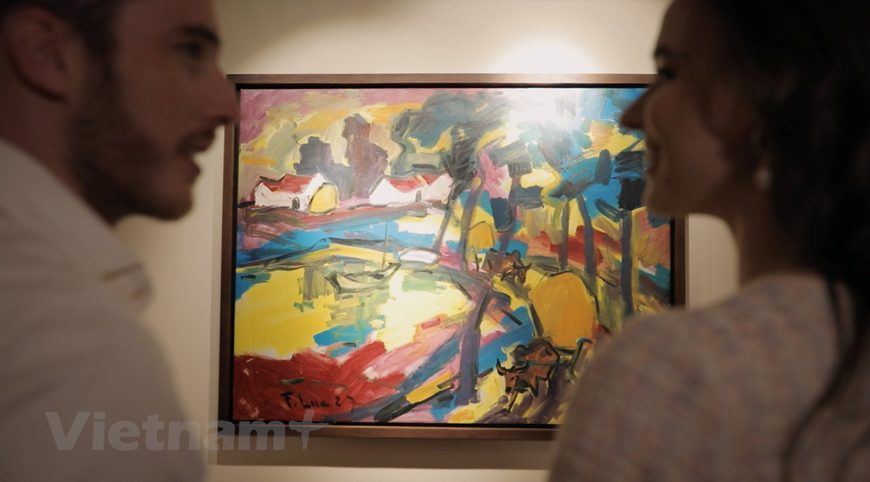
Loving beauty is enjoyable, but creating beauty is art. Paintings beautify and brighten up the decor space on the yacht. When hanging the paintings, we must be sure to avoid shaking them, but they must be easy to remove in case of fire. Special care must be taken in case of stains, with periodical maintenance by experts, and the most precious paintings are covered. The paintings are not only beautiful, but even more, the paintings of painter Pham Luc tell the story of war and peace, traditional culture, heritage, and the development of Vietnamese society through each period, which is where their true value lies. This is a unique privilege that only passengers of Heritage Binh Chuan can enjoy.
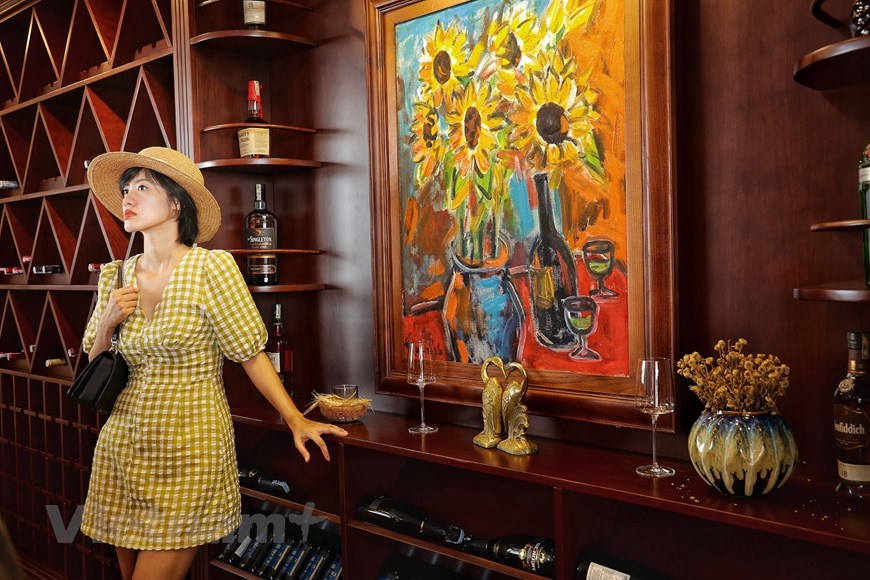
Our owner collected the fine art because of his passion for painting. Pham Ha has spent 25 years collecting paintings with his love of heritage and telling the story of Vietnam’s intangible spirit through art. The story of Vietnamese art is also the history of modern Vietnam. “He is like the person chosen to succeed the king of ships, Bach Thai Buoi.”, writes the Dream Story of the Five Continents, “He pursues his passion for yachts, and builds yachts to display his paintings for visitors to enjoy.” After all, only the most memorable stories, the paintings, are the most valuable asset on a yacht. The older the painting, the more valuable it is. www.heritagecruises.com
DISCOVER VIETNAMESE CULTURE THROUGH PAINTINGS
Exhibiting both French and Vietnamese influences in his work, Pham Luc is a bridge linking the 20th and 21st centuries. To appreciate this accomplished and yet humble master is to understand a part of Vietnamese culture, history, heritage, progress and life.
Some of his older paintings sold for over $400,000 and many have admired his works including a Harvard professor, many ambassadors in Hanoi, high-ranking Vietnamese officials and art collectors from around the world. He has a collectors’ club with over a hundred passionate members in Hanoi.

Soldier and Painter
Pham Luc was born in Hue, Vietnam in 1943 and raised in Hanoi. He was one of the official painters in the Vietnamese army and was awarded prizes in art from the Ministry of Defense in 1990. He still lives in Hanoi and is one of the major painters in this country. His works have been exhibited in France, Germany, USA, Australia, Singapore, Japan and Russia and feature in the collections of Vietnam’s Fine Arts Museum and many international art collectors.
His style
Pham Luc’s style is instantly recognizable but hard to imitate. “I do not paint in abstract. I paint the vibrations of my heart, the life of the people around me… I find serenity in working. My paintings are confessions.”
It is in these terms that the painter describes his style which is full of French influences. In his art Pham Luc exalts the simplicity of rural beauty through the sweetness of women, children or nature.
Pham Luc is influenced by four of the most famous and successful painters in Vietnam since 1945 – Nghiem, Liem, Sang and Phai who all graduated from L’Ecole des Beaux Arts de l’Indochine. These four artists diverged on totally different paths. Nghiem in a world of convention, Liem softness and femininity, Sang was strength, and Phai realism.
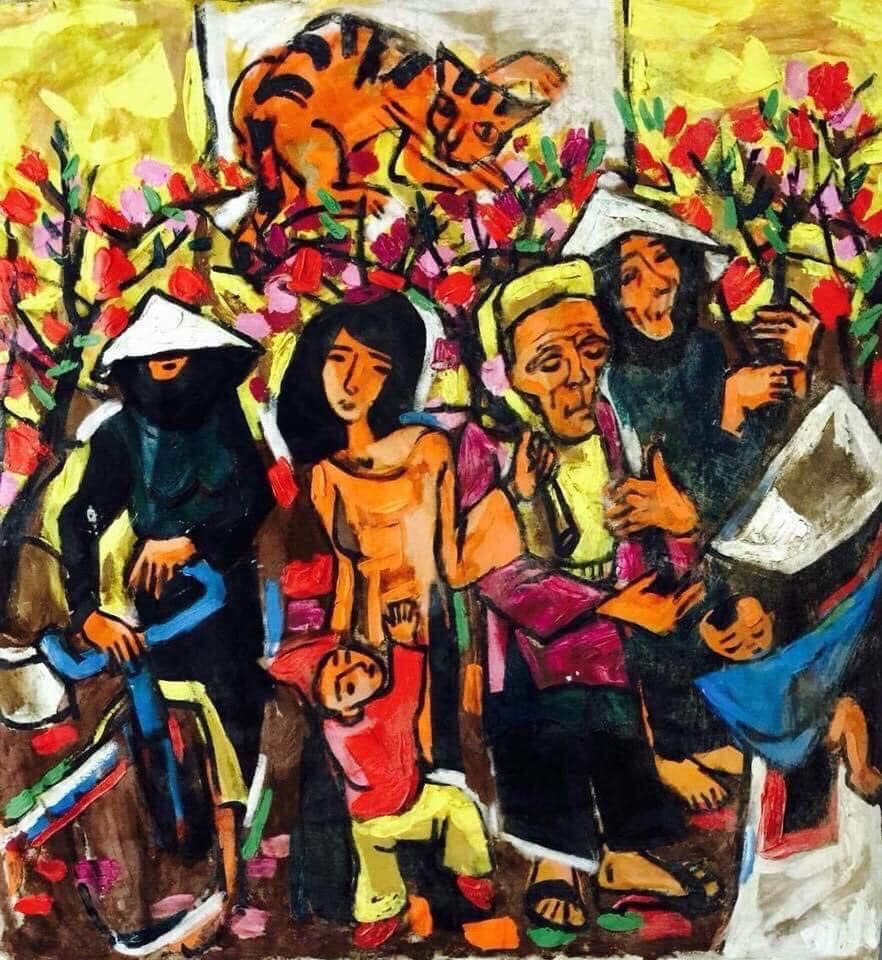
His life as a painter “Painting is my joy in life.”
Pham Luc tirelessly paints nearly a thousand paintings every year. What characterizes him is his ability to adapt to the element he is using. He has created works of art on all possible media: newsprint, craft paper, rice sacks. He also mastered the traditional techniques such as oil, gouache, ink, pastel, and lithography as well as lacquer, deemed the most difficult technique, and inaccessible to many. He is one of the acknowledged masters in this medium.
Pham Luc and war
Pham Luc spent 35 years in the army and was one of the official army painters. Much of his art was produced in haste during the war, on sacks of rice, and bore witness to the horror of the fighting that surrounded him. Art silenced the horror and introduced the essence of hope.
One particular technique: Lacquer
Initiated in China three thousand years ago, the technique of lacquer then spread throughout Southeast Asia. In Vietnam, where lacquer is recognized as a popular art and craft, the process, a long kept national secret, was allowed to be shown to foreign students around 1970 by the Hanoi Fine Arts College. What characterizes it is the application of several layers of color dried in a hot and humid atmosphere. Thanks to grinding techniques, different shapes and colors can be brought out.

Work in ink
Pham Luc’s ink works, painted on locally available materials such as silk, rice sacks, newsprint, and rice paper, are of inestimable historical value. Made between 1965 and 1975, a series of drawings in ink on rice paper represent the soldiers, Vietnamese peasants, and women during the war, mostly passive witnesses of a conflict for unity and independence.
Oils and other techniques
Pham Luc mastered many traditional techniques: from lacquer (he is an undisputed master in Vietnam), water color, oil, woodcarving, and gouache to acrylic. A book that compares him with Picasso is dedicated to him.
 A masterpiece in the natural wonder
A masterpiece in the natural wonder
Built with passion, Heritage Cruises is proudly affiliated with the master Pham Luc as travel, cruising, food, wine, hospitality, music and art represent our rich Vietnamese history, culture, nature, heritage and cuisine which all create memories for the most sophisticated travelers. Discover our masterpiece and 100 artworks on board and create your own memories.
Karst secrets revealed
Cruising in the biggest karst museum in the world!
The Gulf of Tonkin includes some thousands of islands and islets which form a spectacular seascape of limestone pillars. Because of their precipitous nature, most of the islands are uninhabited and relatively unaffected by human influence.
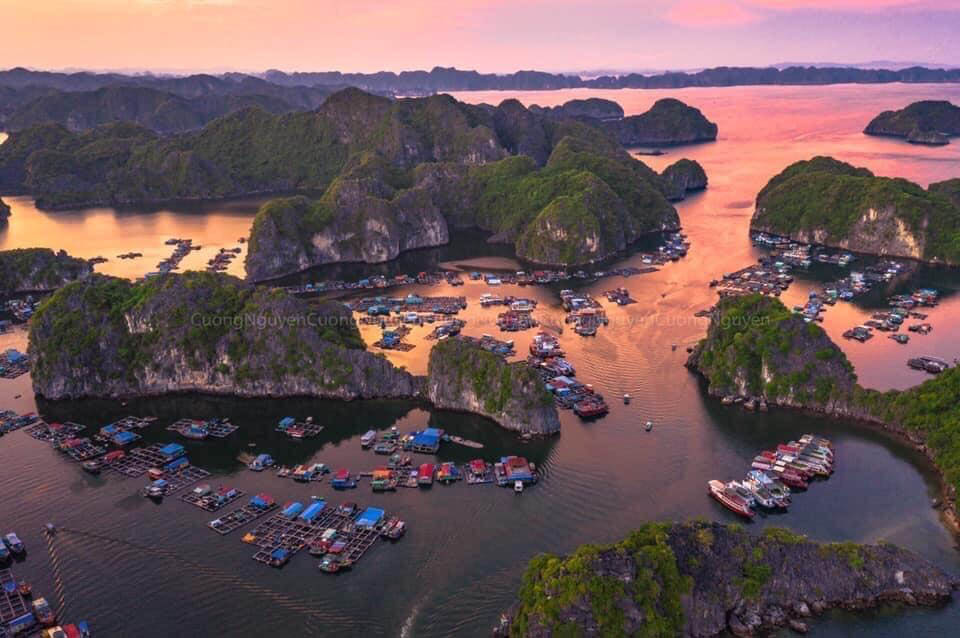
“Karst” is a characteristic weathering phenomenon of limestone mountains eroded by water. The erosion is not caused by mechanical forces, but mainly by carbon dioxide (CO2) in the air dissolving into water, plus positive ions of hydrogen (H+) forming carbonic acid (H2CO3). This is the main culprit of limestone erosion. The natural products of karst weathering are caves with stalactites, stalagmites, and underground rivers and streams.
The geomorphology of the Halong Bay region, including Bai Tu Long Bay, Lan Ha Bay, and Halong Bay itself, is known as “‘drowned karst’ due to the unusual combination of its limestone karst features which have been subject to the repeated rise and fall of the sea over millions of years”. The limestone formations of Halong Bay have been eroded into a mature landscape of fengcong (clusters of conical peaks) and fenglin (isolated tower features, modified later by the invasion of the sea.
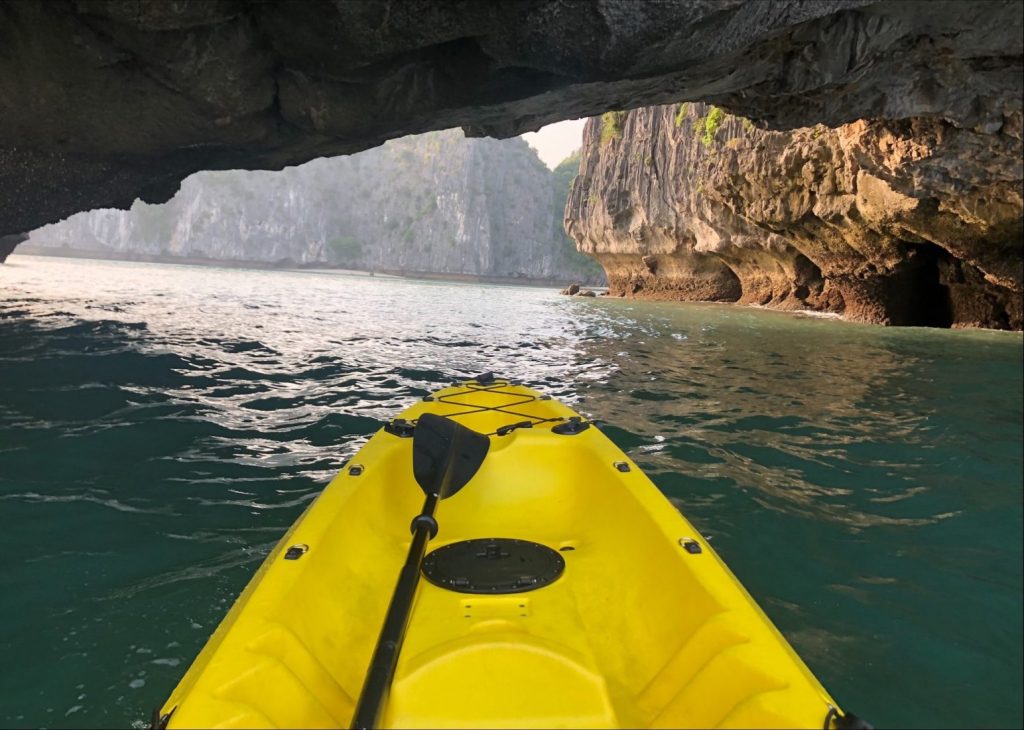
The smaller islands consist of fenglin towers that are 50m to 100m high. Many have vertical walls on all or most sides and these continue to evolve because of rock falls. The sea’s invasion of The Gulf of Tonkin has added an extra element to the normal process of lateral undercutting of the limestone towers and islands.
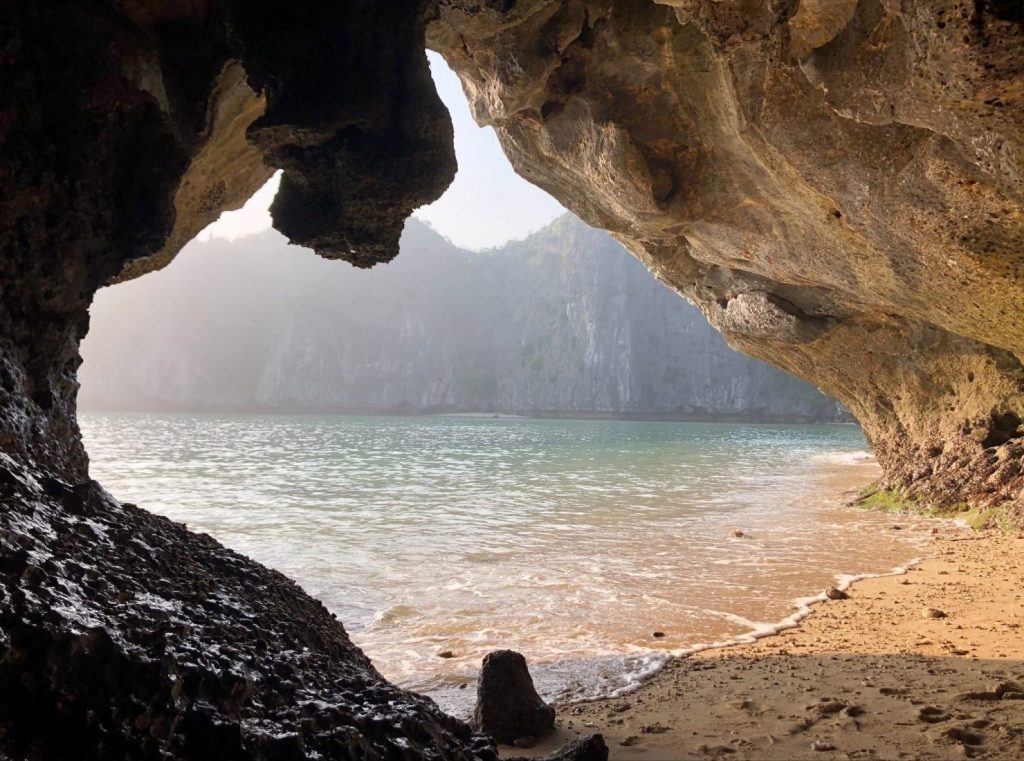
The most conspicuous feature of this erosion is the large notch cut into the entire rocky coastline, which can be seen from the air. Notches are a feature of limestone cliffs worldwide, but those of the Ha Long region are exceptionally well developed and, at many sites, extend into arches and caves. This process of undercutting and subsequent erosion maintains the steep faces of the fenglin karst towers and thereby perpetuates the spectacular nature of the landscape.
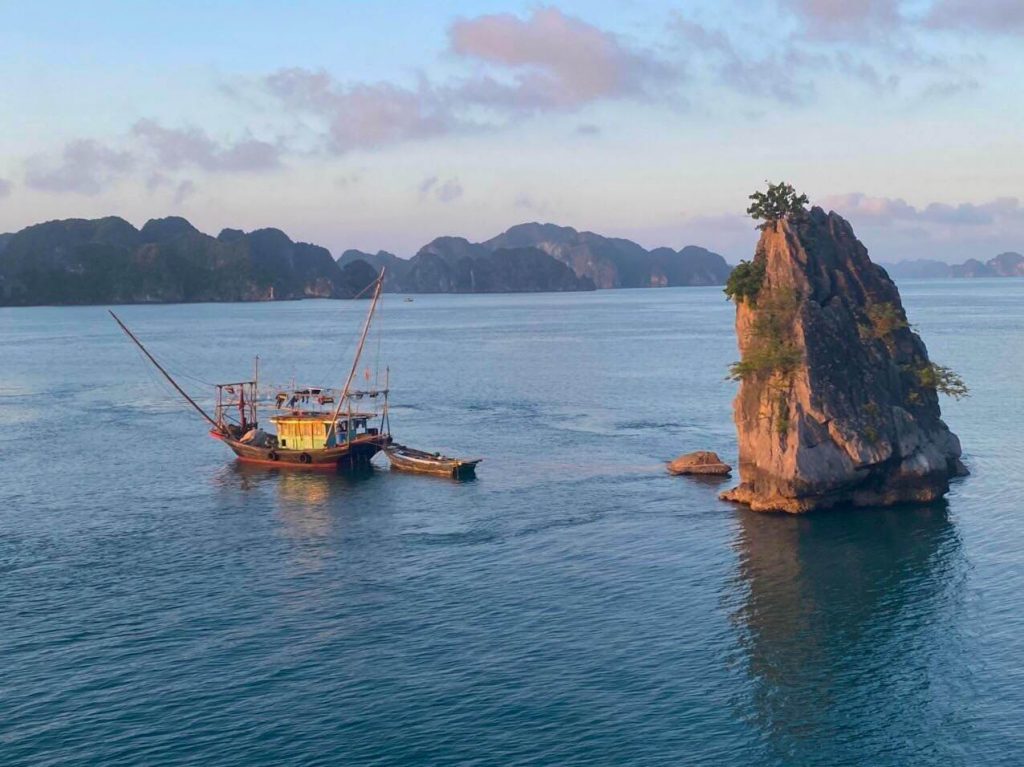
Extensive limestone caves represent another important feature of the Ha Long Region, with three main types identified: old phreatic caves formed below the water table of the time; old karstic foot caves formed by lateral undercutting of cliffs at base level; and marine notch caves formed at sea level where rock structures are powerfully eroded and eventually reduced to a wave-cut platform. You can cruise above the biggest karst garden in the world and discover some dry grottos and eroded caves such as Luon, Ba Ham or Dark and Bright Caves.
